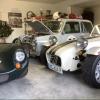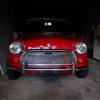
Su Twin Hs2 Tuning For 1080 Ccm Engine
#1

Posted 17 December 2020 - 07:57 PM
I am from Germany and I have recently built a 1080 ccm A-series engine for my 89 Mayfair - the specification is:
+ 100 pistons
lighter flywheel
Minispares Evo 001 camshaft
Minispares electronic ignition
10:1 compression ratio
Minimania cylinder head with 31/26 valves
LCB
RC40 with one silencer
Twin HS2
Ramair Air filter
The engine is running fine but I think acceleration could be better.
At the moment the HS2 specification is needle AAZ, red spring, SAE20 oil.
I also have two AH2 needles, blue springs and different oils.
Do you have any recommendations what to do first?
What causes a spring or oil change?
Regards Stefan
#2

Posted 18 December 2020 - 09:26 AM
Hello,
I am from Germany and I have recently built a 1080 ccm A-series engine for my 89 Mayfair - the specification is:
+ 100 pistons
lighter flywheel
Minispares Evo 001 camshaft
Minispares electronic ignition
10:1 compression ratio
Minimania cylinder head with 31/26 valves
LCB
RC40 with one silencer
Twin HS2
Ramair Air filter
The engine is running fine but I think acceleration could be better.
At the moment the HS2 specification is needle AAZ, red spring, SAE20 oil.
I also have two AH2 needles, blue springs and different oils.
Do you have any recommendations what to do first?
What causes a spring or oil change?
Regards Stefan
hey stefan!
Firstly, no one will be able to advise what needle is needed for your setup as it becomes extremely complicated once you have changed things on your engine - no 2 engines are the same!
With regards to the springs and oils, i have quite some experience now!
The dashpot springs are there to control the height of the piston compared to a certain power requirement of the engine. The stronger the engine/ more power it produces, the more vacuum/suction it creates. The more suction, the more force pulling your dashpot piston up. The spring is there to be tuned to your engines power requirements.
spring too LIGHT: The dashpot piston will shoot up, letting in too much air, causing the mixture to lean out.
spring too HEAVY: the dashpot piston will be held down, effectively choking the carb and forcing more fuel to be sucked in, making the mixture richer.
The only way I have found to get the right spring was to place a camera in my carbs mouth and film its position. What you want is full opening at 100% power. I will link a video here of some tests I did.
The oil is only a reactive element. It does not influence the total position of the piston. It changes the pistons reaction. this means when you stamp on the throttle, the piston moves quickly.
The lighter the oil: the more the piston will "jump", letting more air into the engine, leaning the mixture out.
The heavier the oil: the less the piston will react, letting less air in, forcing the engine to suck more fuel into the carb, caussing richening.
The problem that many people have is they dont take all 3 factors into account: the needle, spring and the oil.
You can mix and match those 3 and end up with something very acceptable.
For example: Light spring+light oil+very rich needle. What will happen is the piston will shoot up quick, will be open too early; which would normally cause leaning out, BUT since the needle is very rich, it will compensate.
It gets complicated fast.... thats why there is no "thats my spec, this needle fits" approach.
What I can advise is getting an AFR gauge. this then changes your approach to setting up the engine, or go to a rolling road and have it set up there. I live in Austria, and theres only one RR...not sure how it is in germany ;)
So to the linked videos:
I found a closed road on a hill and I used a camera to see the position of my dashpot piston at a certain power band. I did tests from 2000-6000 rpm, holding the throttle 100% open and keeping the revs consistent for 5-10 sec.
What this does is show how far up my piston is according to a certain power need. I know by virtue of my cam, than max power is made around 5750-6000 rpm so at this rpm the piston should be fully up. IF it goes up before that, I know the spring is too light. IF it never reaches the top, the spring is too heavy.
I then cross referenced these positions (marked by the numbers on the face of the piston) with my AFR gauge. This way- as a random example, I see that at 100% throttle at 3000rpm, the piston is in position 8 and the AFR was 14. Then I know if I want it to make max power I need to get the afr down to 11.5-12.5. I can then remove the needle, sand it down a bit, retest at the same rpm. This process is continued until the afr is dropped down to 12ish, then I go for 3500rpm. Repeat. Then 4000, etc. That basically how you get the right needle for your engine without a rolling road.
The whole process too me about 2 hours but it was fun and I learned alot.
Hope my rant somehow helps ![]()
#3

Posted 18 December 2020 - 07:13 PM
thank you for your detailed response. It is impressive what you did to set up your carburettors.
As you said it should be fun working on our cars and I will try to achieve a similar result.
Thank you very much and stay healthy!
Stefan
1 user(s) are reading this topic
0 members, 1 guests, 0 anonymous users














